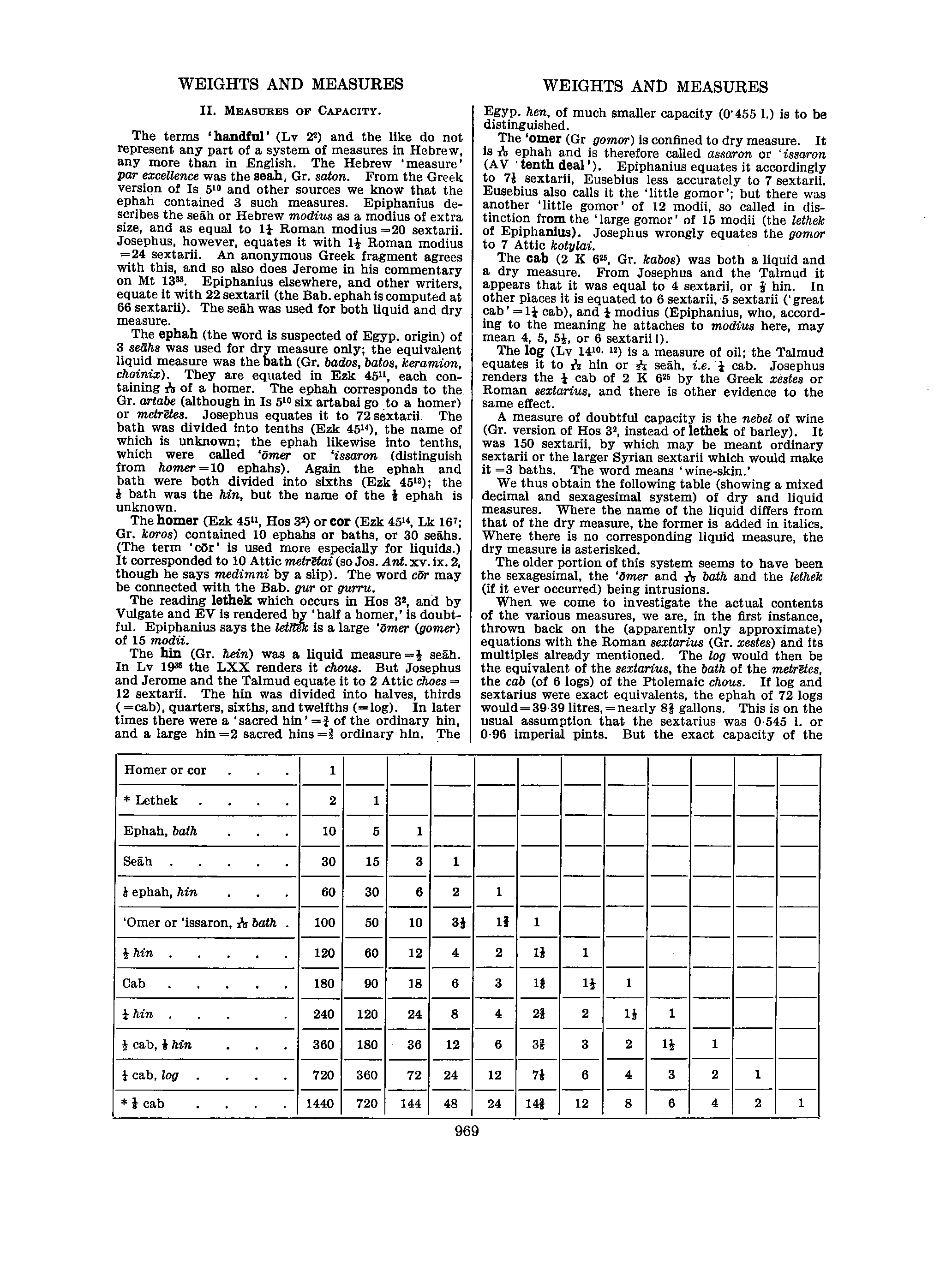WEIGHTS
AND
MEASURES
II.
Measxjres
of
Capacity.
The
terms
'handful'
(Lv
2*)
and
the
like
do
not
represent
any
part
ol
a
system
of
measures
in
Hebrew,
any
more
than
in
English.
The
Hebrew
'measure'
par
excellence
was
the
seah,
Gr.
saion.
From
the
Greek
version
of
Is
S'"
and
other
sources
we
know
that
the
ephah
contained
3
such
measures.
Epiphanius
de-scribes
the
seah
or
Hebrew
modius
as
a
modius
of
extra
size,
and
as
equal
to
li
Roman
modius
=20
sextarii.
Josephus,
however,
equates
it
with
li
Roman
modius
=24
sextarii.
An
anonymous
Greek
fragment
agrees
with
this,
and
so
also
does
Jerome
in
his
commentary
on
Mt
13".
Epiphanius
elsewhere,
and
other
writers,
equate
it
with
22
sextarii
(the
Bab.
ephah
is
computed
at
66
sextarii).
The
seah
was
used
for
both
liquid
and
dry
measure.
The
ephah
(the
word
is
suspected
of
Egyp.
origin)
of
3
scSfts
was
used
for
dry
measure
only;
the
equivalent
liquid
measure
was
the
bath
(Gr.
bados,
batos,
keramion,
choinix).
They
are
equated
in
Ezk
45",
each
con-taining
A
of
a
homer.
The
ephah
corresponds
to
the
Gr.
artabe
(although
in
Is
S'"
six
artabai
go
to
a
homer)
or
metretes.
Josephus
equates
it
to
72
sextarii.
The
bath
was
divided
into
tenths
(Ezk
45"),
the
name
of
which
is
unknown;
the
ephah
likewise
into
tenths,
which
were
called
'omer
or
'issaron
(distinguish
from
homer
=10
ephahs).
Again
the
ephah
and
bath
were
both
divided
into
sixths
(Ezk
IS's);
the
i
bath
was
the
hin,
but
the
name
of
the
i
ephah
is
unknown.
The
homer
(Ezk
45",
Hos
3^)
or
cor
(Ezk
45",
Lk
16';
Gr.
koros)
contained
10
ephahs
or
baths,
or
30
seahs.
(The
term
'cOr'
is
used
more
especially
for
liquids.)
It
corresponded
to
10
Attic
metretai
(so
Jos.
Ant.
xv.
ix.
2,
though
he
says
medimni
by
a
slip).
The
word
cSr
may
be
connected
with
the
Bab.
gw
or
ffurru.
The
reading
lethek
which
occurs
in
Hos
3^,
and
by
Vulgate
and
EV
is
rendered
by
'half
a
homer,'
is
doubt-ful.
Epiphanius
says
the
Idmk
is
a
large
'Bmer
igomer)
of
15
modii.
The
hin
(Gr.
hein)
was
a
liquid
measure
=i
seah.
In
Lv
19»
the
LXX
renders
it
choua.
But
Josephus
and
Jerome
and
the
Talmud
equate
it
to
2
Attic
choes
=
12
sextarii.
The
hin
was
divided
into
halves,
thirds
(
=cab),
quarters,
sixths,
and
twelfths
(=log).
In
later
times
there
were
a
'sacred
hin'
=J
of
the
ordinary
hin,
and
a
large
hin
=2
sacred
hins=i
ordinary
hin.
The
WEIGHTS
AND
MEASURES
Egyp.
hen,
of
much
smaller
capacity
(0'455
1.)
is
to
be
distinguished.
The
'omer
(Gr
gomor)
is
confined
to
dry
measure.
It
is
A
ephah
and
is
therefore
called
assaron
or
'
issaron
(AV
tenth
deal').
Epiphanius
equates
it
accordingly
to
7i
sextarii,
Eusebius
less
accurately
to
7
sextarii.
Eusebius
also
calls
it
the
'little
gomor';
but
there
was
another
'little
gomor'
of
12
modii,
so
called
in
dis-tinction
from
the
'large
gomor'
of
15
modii
(the
lethek
of
Epiphanius).
Josephus
wrongly
equates
the
gomor
to
7
Attic
kotylai.
The
cab
(2
K
6^=,
Gr.
kabos)
was
both
a
liquid
and
a
dry
measure.
From
Josephus
and
the
Talmud
it
appears
that
it
was
equal
to
4
sextarii,
or
J
hin.
In
other
places
it
is
equated
to
6
sextarii,
5
sextarii
('
great
cab'
=
li
cab),
and
i
modius
(Epiphanius,
who,
accord-ing
to
the
meaning
he
attaches
to
modius
here,
may
mean
4,
5,
5i,
or
6
sextarii
I).
The
log
(Lv
1410-
")
is
a
measure
of
oil;
the
Talmud
equates
it
to
A
hin
or
A
seah,
i.e.
i
cab.
Josephus
renders
the
i
cab
of
2
K
e^s
by
the
Greek
xestes
or
Roman
seictarius,
and
there
is
other
evidence
to
the
same
effect.
A
measure
of
doubtful
capacity
is
the
nebel
of
wine
(Gr.
version
of
Hos
3^,
instead
of
lethek
of
barley).
It
was
150
sextarii,
by
which
may
be
meant
ordinary
sextarii
or
the
larger
Syrian
sextarii
which
would
make
it
=3
baths.
The
word
means
'wine-skin.'
We
thus
obtain
the
following
table
(showing
a
mixed
decimal
and
sexagesimal
system)
of
dry
and
liquid
measures.
Where
the
name
of
the
liquid
differs
from
that
of
the
dry
measure,
the
former
is
added
in
italics.
Where
there
is
no
corresponding
liquid
measure,
the
dry
measure
is
asterisked.
The
older
portion
of
this
system
seems
to
have
been
the
sexagesimal,
the
'Om^
and
A
bath
and
the
lethek
(if
it
ever
occurred)
being
intrusions.
When
we
come
to
investigate
the
actual
contents
of
the
various
measures,
we
are,
in
the
first
instance,
thrown
back
on
the
(apparently
only
approximate)
equations
with
the
Roman
sextarius
(Gr.
xestes)
and
its
multiples
already
mentioned.
The
log
would
then
be
the
equivalent
of
the
sextarius,
the
bath
of
the
metroes,
the
cab
(of
6
logs)
of
the
Ptolemaic
chous.
It
log
and
sextarius
were
exact
equivalents,
the
ephah
of
72
logs
would=39-39
litres,
=
nearly
88
gallons.
This
is
on
the
usual
assumption
that
the
sextarius
was
0-545
1.
or
0-96
imperial
pints.
But
the
exact
capacity
of
the

